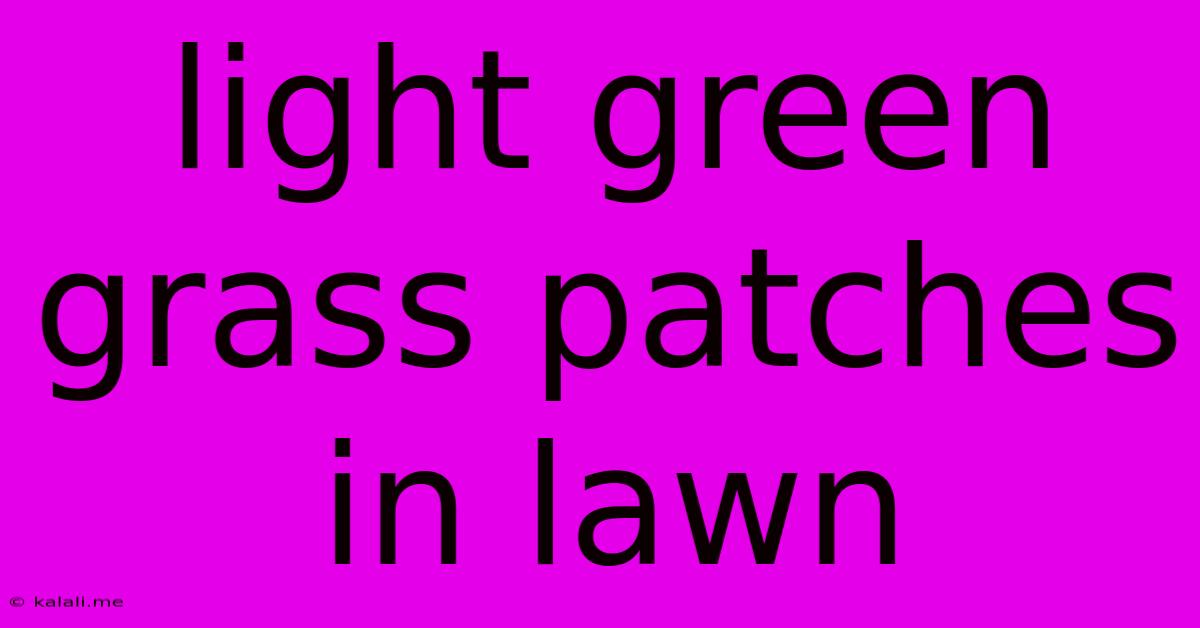Light Green Grass Patches In Lawn
Kalali
May 24, 2025 · 3 min read

Table of Contents
Light Green Grass Patches: Diagnosing and Fixing Your Lawn's Uneven Hue
Are those light green patches in your lawn causing you concern? A vibrant, emerald green lawn is the envy of the neighborhood, but uneven coloration can signal underlying problems. This article will help you diagnose the cause of those lighter patches and provide solutions to restore your lawn's lush, healthy appearance. We'll cover common culprits like insufficient sunlight, nutrient deficiencies, pests, disease, and improper watering techniques.
Understanding the Causes of Light Green Grass Patches
Several factors can contribute to light green or yellowish areas in your lawn. Identifying the root cause is crucial for effective treatment. Let's explore some of the most frequent offenders:
1. Lack of Sunlight:
Grasses require adequate sunlight for photosynthesis. Areas shaded by trees, buildings, or even taller plants can receive insufficient sunlight, leading to thinner, lighter-colored grass. This is especially true for shade-tolerant grasses which might still appear lighter than their sun-drenched counterparts.
2. Nutrient Deficiencies:
Nutrient deficiencies, particularly nitrogen, are a common cause of light green patches. Nitrogen is vital for chlorophyll production, which gives grass its green color. A lack of nitrogen can result in pale, yellowing grass. Other deficiencies, like iron or potassium, can also contribute to discoloration. A soil test can accurately pinpoint nutrient imbalances.
3. Pests and Diseases:
Various pests and diseases can attack your lawn, resulting in discoloration. Grubs, chinch bugs, and other insects can damage the roots and blades of grass, causing yellowing or browning. Fungal diseases like dollar spot or brown patch can also lead to irregular patches of lighter-colored grass. Careful inspection is necessary to identify the specific pest or disease affecting your lawn.
4. Improper Watering:
Both underwatering and overwatering can negatively impact your lawn's color. Underwatered lawns will appear dry, brown, and brittle. However, constantly soggy soil can suffocate grass roots, leading to light green or yellow patches as the grass struggles to absorb nutrients. Consistent, deep watering is crucial for a healthy lawn.
5. Soil Compaction:
Hard, compacted soil restricts root growth and limits the grass's ability to absorb water and nutrients. This can lead to thin, stressed grass that appears light green or yellow. Aerating your lawn can improve soil drainage and aeration.
Treating Light Green Grass Patches: A Step-by-Step Guide
Once you've identified the cause of the light green patches, you can take steps to rectify the situation:
-
Address Shade Issues: If shade is the culprit, consider pruning overhanging branches, relocating tall plants, or opting for shade-tolerant grass varieties.
-
Apply Fertilizer: If nutrient deficiencies are at play, a soil test will guide you on which fertilizers to use. Choose a fertilizer appropriate for your grass type and soil conditions. Always follow package instructions. Consider slow-release fertilizers for consistent nutrient delivery.
-
Pest and Disease Control: If pests or diseases are identified, treat your lawn with appropriate insecticides or fungicides. Organic options are available for eco-conscious lawn care. Early detection and treatment are key to preventing widespread damage.
-
Improve Watering Practices: Water deeply and less frequently to encourage deep root growth. Avoid overwatering, which can lead to root rot. Consider using a soil moisture meter to gauge soil moisture levels.
-
Aerate the Soil: If soil compaction is a problem, core aeration will help improve drainage and aeration, allowing roots to access water and nutrients more easily.
Prevention is Key:
Maintaining a healthy lawn involves proactive steps:
- Regular fertilization: A balanced fertilization schedule provides essential nutrients.
- Proper watering: Water deeply and less often.
- Regular mowing: Mow at the correct height for your grass type.
- Weed control: Prevent weeds from competing with your grass for resources.
By understanding the causes of light green grass patches and taking appropriate action, you can restore your lawn to its vibrant, healthy best. Remember, a healthy lawn is a beautiful lawn!
Latest Posts
Latest Posts
-
Assassins Creed Black Flag How To Use Mortars
May 25, 2025
-
3 Way Switch With 4 Way Switch
May 25, 2025
-
You Attract More Flies With Honey Than Vinegar
May 25, 2025
-
Should I Replace Rotors With Pads
May 25, 2025
-
Blender How To Select Through Object
May 25, 2025
Related Post
Thank you for visiting our website which covers about Light Green Grass Patches In Lawn . We hope the information provided has been useful to you. Feel free to contact us if you have any questions or need further assistance. See you next time and don't miss to bookmark.